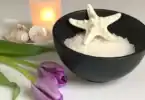Sea Salt spray for textured hair is all the rage these days! But a small bottle of this stuff can start at about $10 and some of the brands charge up to four times that much. Those kind of prices make you wonder if you couldn’t just make your own DIY Salt Spray.
In this article I look at what salt spray is intended for and what kind of hair and hair styles it benefits. I also share my own recipe for a simple, yet effective salt spray for texturing hair.
What’s the Purpose of Sea Salt Spray for Hair?
Salt spray is intended to give flat & limp hair a textural lift, just as if you had just returned from the beach. Have you ever noticed how the bit of salt spray from the ocean blowing through the air accumulates on your hair and skin? That little bit of salty grittiness can volumeize and texturize your hair in a good way. It keeps the individual hair shafts from sliding against each other and results in a more full look. If you have some natural waves or curliness, the salt spray can help define that look.
I will say up front that Sea Salt Spray works great for certain hair types, and for certain styles or ‘looks’. For other people, they report that they just felt like the spray made them feel ‘messy’ and one guy reported that it helped her with his dreadlocks because it made his hair more tangly. So since Sea Salt Spray may or may not be your thing, why spend 10 or even 30 bucks to check it out. You may even have most of the ingredients available at home to try this out. If your hair loves it, maybe you can splurge later and compare the DIY salt spray against the brandname versions.
How to Use Sea Salt Spray
DIY Salt spray can be applied to either damp or dry hair. You just spray it in, and then fluff or crimp your hair, depending on your hair and the style you are trying to achieve. The salt residue that dries on each hair will make it a bit stiffer and will help it to stand up a bit, instead of laying as flat to your scalp. Once it is dry, it will have a light holding effect that will last until you rinse or shampoo it out. Avoid trying to brush your hair once you have applied the spray.
My experience (somewhat curly, but very fine hair) is that the salt spray works a lot like a ‘light hold’ hair spray. I spray it in to revive my curls before going out for dinner or evening events. I scrunch or shape my hair to get the look I want, and then the spray quickly dries, and tends to hold the shape in place. I love it!
Once the spray dries, I find that just like aerosol hair sprays, the best thing to do is to leave your hair alone. Don’t try to brush or comb it. If you need a little more shaping, just apply a little more of your sea salt spray and arrange your hair with your fingers.
People report using salt sprays before braiding their hair, and then allowing it to dry. When the braids are taken out, they get a nice wavy look that holds its shape. Obviously this salt spray is going to work well for certain hair types and styles, but not well for others. Creating a DIY spray gives you a chance to see if it works for your hair type without making a big investment.
One of the beauties of salt is that it is very water soluble – so this spray is easy to make. It is also easy to remove from your hair and the salt will not cause buildup over time.
A Few Pros & Cons to Consider
While the immediate benefit of salt spray is for styling your hair, it may also contribute to the health of your hair. Some may see hair health improvements from the minerals in the salt, like magnesium and potassium. There is research that these minerals may help strengthen hair follicles and encourage healthy hair growth. People with very oily hair may notice that salt spray will help manage the extra oil.
People with very dry or brittle hair should take caution with salt spray, or use it in conjunction with moisturizing hair products. Salts act as desiccants – drying agents – so if your hair is already dry this salt spray method may not be for you. If you do use it on occasion, be sure to rinse or shampoo between each use and use your normal conditioner and leave-in conditioner.
How to Make Homemade Sea Salt Spray
Make this in small batches for freshness. The salt spray doesn’t really ‘go bad’ but the oil-based products can get a bit gummy over time, clogging the sprayer or potentially changing the texture of the spray when it is on your hair.
Find a spray bottle that disperses liquid in a smooth & fine dispersal pattern. Make sure it is clean and run some water through the sprayer to make sure the tube doesn’t have any residue. The bottle should be 10 ounce capacity or larger.
Add these items to your spray bottle:
- 1 cup (8oz) distilled water. Tap water has impurities (calcium, iron) and additives (fluoride, chlorine – although this eventually dissipates) so Distilled is the best choice, Reverse Osmosis filtered water is the second best choice.
- 1 tablespoon Epsom salt, plain without fragrance or additives.
- 1 teaspoon of leave-in conditioner. This is to counteract the drying effect of the magnesium salt. You could also use a bit of Jojoba or Argan oil, aloe vera, or similar product designed for moisturizing.
- (Optional) 2-3 drops of essential oil for fragrance – I prefer Lavender or Rosemary oil, but go with what makes you smile.
- (Optional) 1 teaspoon Sea Salt – use the naturally evaporated kind, non-Iodized (and no other additives). I usually use this if for no other reason than I want it to match it’s name.
Once everything is in the spray bottle, shake the solution really, really well. Shake it again before each application to your hair.

My spray comes out looking opaque yellow when it is mixed up. This is because of the leave-in conditioner I use that contains quite a bit of Argan oil.
If you find that your spray does not hold quite as much texture or volume as you’d like, you can add another 1/2 T of the Epsom salt. At some point, more is not better. If you add too much Epsom salt the water will reach saturation and the excess salt will just sit in the bottom of the bottle.
Some people wonder if they could just get the essential oils on the list by buying the Epsom salt that is blended for fragrant baths, but those additives are designed for skin and some of them may not be great for hair. Read the label on the Epsom salt that you are considering – if they give the exact ingredients you may be able to tell if using scented salts are okay, but I think you’ll have more reliable results with plain Epsom salt with no additives.
Compare Sea Salt Spray Products for Hair
I find that I like my DIY sea salt spray even better once I’ve compared it to a commercially available product. It avoids FOMO (fear of missing out) when I know for sure that my mixture works just as well and costs so much less. If you are looking for a product to compare, or you just don’t have time or inclination to go the DIY route, this is a product that I can suggest: Level 3 Sea Salt Texturing Spray. If you find that you like it, it is one of the better priced choices out there. If you prefer DIY, the spray bottle is really a nice one so you could repurpose it to dispense your homemade version.
Final Thoughts
I hope that your hair benefits from this easy DIY Salt spray – and that you get lots of compliments on your new ‘beach look’!
If you are seeking other good ways to use up that big bag of Epsom salt, be sure to check out this article: Unwind and De-Stress: 9 Ways to Use Epsom Salt in Your Bath where we discuss a variety of soaking and other self care related tips.
Featured Photo by Serg Alesenko







